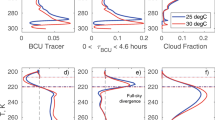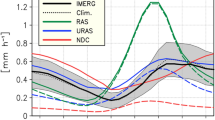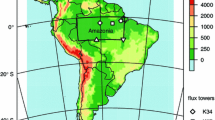Abstract
A convection scheme for climate model is developed based on Tiedtke’s (Mon Weather Rev 117:1779–1800, 1989) bulk mass flux framework and is evaluated with observational data and cloud resolving model simulation data. The main differences between the present parameterization and Tiedtke’s parameterization are the convection trigger, fractional entrainment and detrainment rate formulations, and closure method. Convection is triggered if the vertical velocity of a rising parcel is positive at the level at which the parcel is saturated. The fractional entrainment rate depends on the vertical velocity and buoyancy of the parcel as well as the environmental relative humidity. For the fractional detrainment rate, a linear decrease in the updraft mass flux above maximum buoyancy level is assumed. In the closure method, the cloud base mass flux is determined by considering both cloud layer instability and subcloud layer turbulent kinetic energy as controlling factors in the strength of the convection. The convection scheme is examined in a single column framework as well as using a general circulation model. The present bulk mass flux (BMF) scheme is compared with a simplified Relaxed Arakawa-Schubert (RAS) scheme. In contrast to the RAS, which specifies the cloud top, cloud top height in BMF depends on environmental properties, by considering the conditions of both the parcel and its environment in a fractional entrainment and detrainment rate formulations. As a result, BMF shows improved sensitivity in depth and strength of convection on environmental humidity compared to RAS, by strengthening coupling between cloud and environment. When the mid to lower troposphere is dry, the cloud resolving model and BMF produce cloud top around the dry layer and moisten the layer. In the framework of general circulation model, enhanced coupling between convection and environmental humidity in BMF results in improved representation of eastward propagating intraseasonal variability in the tropics—the Madden-Julian oscillation.
















Similar content being viewed by others
References
Arakawa A, Schubert WH (1974) Interaction of a cumulus cloud ensemble with the large-scale environment, part I. Journal of the Atmospheric Sciences 31:674–701
Bechtold P, Köhler M, Jung T, Doblas-Reyes F, Leutbecher M, Rodwell MJ, Vitart F, Balsamo G (2008) Advances in simulating atmospheric variability with the ECMWF model: From synoptic to decadal time-scales. Q J R Meteorol Soc 134:1337–1351. doi:10.1002/qj.289
Biasutti M, Sobel AH, Kushnir Y (2006) AGCM precipitation biases in the tropical Atlantic. J Clim 19:935–958
Bonan GB (1996) A land surface model (LSM version 1.0) for ecological, hydrological, and atmospheric studies: technical description and user’s guide. PB–97-131494/XAB, National Center for Atmospheric Research, Boulder, CO (United States) (Climate and Global Dynamics Div)
Bretherton CS, Smolarkiewicz PK (1989) Gravity waves, compensating subsidence and detrainment around cumulus clouds. Journal of the Atmospheric Sciences 46:740–759
Bretherton CS, Peters ME, Back LE (2004) Relationships between water vapor path and precipitation over the tropical oceans. J Clim 17:1517–1528
Brown RG, Zhang C (1997) Variability of midtropospheric moisture and its effect on cloud-top height distribution during TOGA COARE*. Journal of the Atmospheric Sciences 54:2760–2774
Chaboureau J-P, Guichard F, Redelsperger J-L, Lafore J-P (2004) The role of stability and moisture in the diurnal cycle of convection over land. Q J R Meteorol Soc 130:3105–3117. doi:10.1256/qj.03.132
Chou MD, Suarez MJ (1994) An efficient thermal infrared radiation parameterization for use in general circulation models. NASA Tech Memo 104606:85
Chou MD, Suarez MJ (1999) A solar radiation parameterization for atmospheric studies. Technical report series on global modeling and data assimilation, NASA Tech Memo 15:40
Ciesielski PE, Johnson RH, Haertel PT, Wang J (2003) Corrected TOGA COARE sounding humidity data: impact on diagnosed properties of convection and climate over the warm pool. J Clim 16:2370–2384
Cohen C (2000) A quantitative investigation of entrainment and detrainment in numerically simulated cumulonimbus clouds. Journal of the Atmospheric Sciences 57:1657–1674
de Roode SR, Duynkerke PG, Siebesma AP (2000) Analogies between massflux and Reynolds-averaged equations. J Atmos Sci 57:1585–1598
De Rooy WC, Siebesma AP (2008) A simple parameterization for detrainment in shallow cumulus. Mon Weather Rev 136:560–576
Derbyshire SH, Beau I, Bechtold P, Grandpeix JY, Piriou JM, Redelsperger JL, Soares PMM (2004) Sensitivity of moist convection to environmental humidity. Quarterly Journal of the Royal Meteorological Society 130:3055–3079
Grabowski WW (2003) MJO-like coherent structures: Sensitivity simulations using the cloud-resolving convection parameterization (CRCP). Journal of the Atmospheric Sciences 60:847–864
Grant ALM (2001) Cloud-base fluxes in the cumulus-capped boundary layer. Q J R Meteorol Soc 127:407–421. doi:10.1002/qj.49712757209
Grant ALM, Brown AR (1999) A similarity hypothesis for shallow-cumulus transports. Q J R Meteorol Soc 125:1913–1936. doi:10.1002/qj.49712555802
Gregory D (2001) Estimation of entrainment rate in simple models of convective clouds. Q J R Meteorol Soc 127:53–72. doi:10.1002/qj.49712757104
Holloway CE, Neelin JD (2009) Moisture vertical structure, column water vapor, and tropical deep convection. Journal of the Atmospheric Sciences 66:1665–1683
Holtslag AAM, Boville BA (1993) Local versus nonlocal boundary-layer diffusion in a global climate model. J Clim 6:1825–1842
Holtslag AAM, Moeng CH (1991) Eddy diffusivity and countergradient transport in the convective atmospheric boundary layer. Journal of the Atmospheric Sciences 48:1690–1698
Huffman GJ, Adler RF, Morrissey MM, Bolvin DT, Curtis S, Joyce R, McGavock B, Susskind J (2001) Global precipitation at one-degree daily resolution from multisatellite observations. Journal of Hydrometeorology 2:36–50
Jakob C, Siebesma AP (2003) A new subcloud model for mass-flux convection schemes: Influence on triggering, updraft properties, and model climate. Mon Weather Rev 131:2765–2778
Johnson DE, Tao WK, Simpson J, Sui CH (2002) A study of the response of deep tropical clouds to large-scale thermodynamic forcings. Part I: modeling strategies and simulations of TOGA COARE convective systems. Journal of the Atmospheric Sciences 59:3492–3518
Kalnay E, Kanamitsu M, Kistler R, Collins W, Deaven D, Gandin L, Iredell M, Saha S, White G, Woollen J, Zhu Y, Chelliah M, Ebisuzaki W, Higgins W, Janowiak J, Mo KC, Ropelewski C, Wang J, Leetmaa A, Reynolds R, Jenne R, Joseph D (1996) The NCEP/NCAR 40-year reanalysis project. Bull Am Meteorol Soc 77:437–471
Khairoutdinov M, Randall DA (2001) A cloud resolving model as a cloud parameterization in the NCAR community climate system model: preliminary results. Geophys Res Lett 28:3617–3620
Kim D, Kug JS, Kang IS, Jin FF, Wittenberg AT (2008) Tropical Pacific impacts of convective momentum transport in the SNU coupled GCM. Climate Dynamics 31:213–226
Klemp JB, Wilhelmson RB (1978) The simulation of three-dimensional convective storm dynamics. Journal of the Atmospheric Sciences 35:1070–1096
Kuang Z, Bretherton CS (2006) A mass-flux scheme view of a high-resolution simulation of a transition from shallow to deep cumulus convection. Journal of the Atmospheric Sciences 63:1895–1909
Le Treut H, Li ZX (1991) Sensitivity of an atmospheric general circulation model to prescribed SST changes: Feedback effects associated with the simulation of cloud optical properties. Climate Dynamics 5:175–187
Lee MI, Kang IS, Kim JK, Mapes BE (2001) Influence of cloud-radiation interaction on simulating tropical intraseasonal oscillation with an atmospheric general circulation model. Journal of Geophysical Research-Atmospheres 106:14219–14233
Lee MI, Kang IS, Mapes BE (2003) Impacts of cumulus convection parameterization on aqua-planet AGCM simulations of tropical intraseasonal variability. J Meteorol Soc Jpn 81:963–992
Lee MI, Schubert SD, Suarez MJ, Schemm JKE, Pan HL, Han J, Yoo SH (2008) Role of convection triggers in the simulation of the diurnal cycle of precipitation over the United States Great Plains in a general circulation model. Journal of Geophysical Research-Atmospheres 113:D02111
Lin C (1999) Some bulk properties of cumulus ensembles simulated by a cloud-resolving model. Part II: Entrainment profiles. Journal of the Atmospheric Sciences 56:3736–3748
Lin YL, Farley RD, Orville HD (1983) Bulk parameterization of the snow field in a cloud model. J Appl Meteorol 22:1065–1092
Lin JL, Kiladis GN, Mapes BE, Weickmann KM, Sperber KR, Lin WY, Wheeler M, Schubert SD, Del Genio A, Donner LJ, Emori S, Gueremy J-F, Hourdin F, Rasch PJ, Roeckner E, Scinocca JF (2006) Tropical intraseasonal variability in 14 IPCC AR4 climate models. Part I: Convective signals. J Clim 19:2665–2690
Lin JL, Lee MI, Kim D, Kang IS, Frierson DMW (2008) The impacts of convective parameterization and moisture triggering on AGCM-simulated convectively coupled equatorial waves. J Clim 21:883–909
Maloney ED, Hartmann DL (2001) The sensitivity of intraseasonal variability in the NCAR CCM3 to changes in convective parameterization. J Clim 14:2015–2034
Moncrieff MW, Krueger SK, Gregory D, Redelsperger JL, Tao WK (1997) GEWEX cloud system study (GCSS) working group 4: precipitating convective cloud systems. Bull Am Meteorol Soc 78:831–845
Moorthi S, Suarez MJ (1992) Relaxed Arakawa-Schubert. A parameterization of moist convection for general circulation models. Mon Weather Rev 120:978–1002
Nakajima T, Tsukamoto M, Tsushima Y, Numaguti A, Kimura T (1995) Modelling of the radiative process in a AGCM. Clim Syst Dyn Modell 3:104–123
Neale RB, Richter JH, Jochum M (2008) The impact of convection on ENSO: from a delayed oscillator to a series of events. J Clim 21:5904–5924
Neggers RAJ, Siebesma AP, Lenderink G, Holtslag AAM (2004) An evaluation of mass flux closures for diurnal cycles of shallow cumulus. Mon Weather Rev 132:2525–2538
Nordeng TE (1994) Extended versions of the convective parametrization scheme at ECMWF and their impact on the mean and transient activity of the model in the tropics. European Centre for Medium-Range Weather Forecasts
Numaguti A, Takahashi M, Nakajima T, Sumi A (1995) Development of an atmospheric general circulation model. Climate System Dynamics and Modeling 3:1–27
Ogura Y, Cho HR (1973) Diagnostic determination of cumulus cloud populations from observed large-scale variables. Journal of the Atmospheric Sciences 30:1276–1286
Petch JC, Willett M, Wong RY, Woolnough SJ (2007) Modelling suppressed and active convection. Comparing a numerical weather prediction, cloud-resolving and single-column model. Q J R Meteorol Soc 133:1087–1100. doi:10.1002/qj.109
Randall DA, Curry J, Duynkerke P, Krueger S, Miller M, Moncrieff M, Ryan B, Starr D, Rossow W, Tselioudis G, Wielicki B (2000) The second GEWEX cloud system study science and implementation plan. IGPO Publication Series 34:45
Raymond DJ (2001) A new model of the Madden-Julian oscillation. J Atmos Sci 58:2807–2819
Ridout JA (2002) Sensitivity of tropical Pacific convection to dry layers at mid-to upper levels: simulation and parameterization tests. Journal of the Atmospheric Sciences 59:3362–3381
Rutledge SA, Hobbs PV (1984) The mesoscale and microscale structure and organization of clouds and precipitation in midlatitude cyclones. XII: A diagnostic modeling study of precipitation development in narrow cold-frontal rainbands. Journal of the Atmospheric Sciences 41:2949–2972
Sherwood SC (1999) Convective precursors and predictability in the tropical western pacific. Mon Weather Rev 127:2977–2991
Sherwood SC, Minnis P, McGill, M (2004) Deep convective cloud-top heights and their thermodynamic control during CRYSTAL-FACE. J Geophys Res 109:D20119. doi:10.1029/2004JD004811
Siebesma AP (1998) Shallow cumulus convection. Buoyant Convection in Geophysical Flows 513:441–486
Simpson J, Wiggert V (1969) Models of precipitating cumulus towers. Mon Weather Rev 97:471–489
Stan C, Khairoutdinov M, DeMott CA, Krishnamurthy V, Straus DM, Randall DA, Kinter III JL, Shukla J (2010) An ocean–atmosphere climate simulation with an embedded cloud resolving model. Geophys Res Lett 37:L01702. doi:10.1029/2009GL040822
Swann H (2001) Evaluation of the mass-flux approach to parametrizing deep convection. Q J R Meteorol Soc 127:1239–1260. doi:10.1002/qj.49712757406
Takayabu YN, Yokomori J, Yoneyama K (2006) A diagnostic study on interactions between atmospheric thermodynamic structure and cumulus convection over the tropical western Pacific Ocean and over the Indochina Peninsula.
 84:151–169
84:151–169Tao WK, Simpson J (1993) Goddard cumulus ensemble model. Part I: Model description. Terr Atmos Oceanic Sci 4:35–72
Tao WK, Simpson J, Baker D, Braun S, Chou MD, Ferrier B, Johnson D, Khain A, Lang S, Lynn B (2003) Microphysics, radiation and surface processes in the Goddard Cumulus Ensemble (GCE) model. Meteorology and Atmospheric Physics 82:97–137
Thayer-Calder K, Randall DA (2009) The role of convective moistening in the Madden-Julian oscillation. J Atmos Sci 66:3297–3312
Tiedtke M (1984) The sensitivity of the time-mean large-scale flow to cumulus convection in the ECMWF model. 297–316
Tiedtke M (1989) A comprehensive mass flux scheme for cumulus parameterization in large-scale models. Mon Weather Rev 117:1779–1800
Tokioka T, Yamazaki K, Kitoh A, Ose T (1988) The equatorial 30–60 day oscillation and the Arakawa-Schubert penetrative cumulus parameterization. J Meteorol Soc Jpn 66:883–901
Tompkins AM (2001) Organization of tropical convection in low vertical wind shears: the role of water vapor. Journal of the Atmospheric Sciences 58:529–545
Troen IB, Mahrt L (1986) A simple model of the atmospheric boundary layer; sensitivity to surface evaporation. Boundary-Layer Meteorology 37:129–148
Uppala SM et al (2005) The ERA-40 re-analysis. Quart J Roy Meteor Soc 131:2961–3012
Wang WQ, Schlesinger ME (1999) The dependence on convection parameterization of the tropical intraseasonal oscillation simulated by the UIUC 11-layer atmospheric GCM. J Clim 12:1423–1457
Wang B, Ding Q, Fu X, Kang I-S, Jin K, Shukla J, Doblas-Reyes F (2005) Fundamental challenge in simulation and prediction of summer monsoon rainfall. Geophys Res Lett 32:L15711. doi:10.1029/2005GL022734
Webster PJ, Lukas R (1992) TOGA COARE: The coupled ocean?atmosphere response experiment. Bull Am Meteorol Soc 73:1377–1416
Willett MR, Bechtold P, Williamson DL, Petch JC, Milton SF, Woolnough SJ (2008) Modelling suppressed and active convection: comparisons between three global atmospheric models. Q J R Meteorol Soc 134:1881–1896. doi:10.1002/qj.317
Wu XQ, Liang XZ, Zhang GJ (2003) Seasonal migration of ITCZ precipitation across the equator: why can’t GCMs simulate it? Geophys Res Lett 30:1824
Wu R, Kirtman B, Pegion K (2006) Local air–sea relationship in observations and model simulations. J Climate 19:4914–4932
Wu X, Deng L, Song X, Vettoretti G, Peltier WR, Zhang GJ (2007) Impact of a modified convective scheme on the Madden-Julian oscillation and El Nino-Southern oscillation in a coupled climate model. Geophys Res Lett 34:16823
Author information
Authors and Affiliations
Corresponding author
Additional information
An erratum to this article can be found at http://dx.doi.org/10.1007/s00382-011-1017-1
Rights and permissions
About this article
Cite this article
Kim, D., Kang, IS. A bulk mass flux convection scheme for climate model: description and moisture sensitivity. Clim Dyn 38, 411–429 (2012). https://doi.org/10.1007/s00382-010-0972-2
Received:
Accepted:
Published:
Issue Date:
DOI: https://doi.org/10.1007/s00382-010-0972-2





 84:151–169
84:151–169